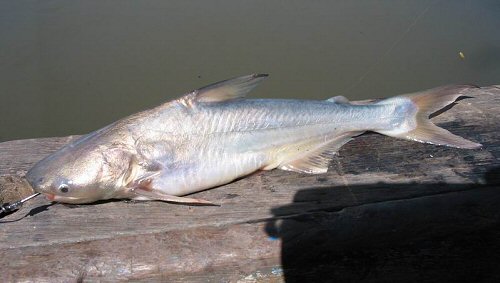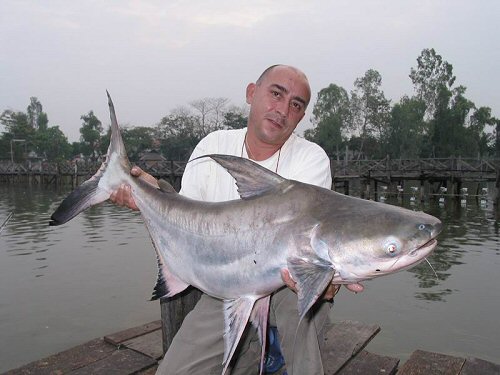
Pangasius
sanitwongsei
After a few questions,
the identity of the catfish was established –
a member of the Pangasius
genus, I was not in the least surprised by this revelation
– I’m afraid I’ve heard it many
times before, but I was very concerned with the next
bit of information that my in-depth questioning produced.
As if it wasn’t bad enough that there was a
large psychotic catfish needing a new home, I identified
it as a Paroon Shark, Pangasius sanitwongsei,
one of the five largest species of catfish in the
world, with a maximum size of over nine feet.
Its owners were
very fond of it, and had tried to re-home it to caring
homes many times but no one would take it. They had
asked all the fish shops in their area – they
had telephoned various zoos and Sea-Life Centres,
but to no avail. They were desperate – could
we help them?
I was reminded
of an incident in which I was involved a couple of
months ago whilst browsing in a well known West London
aquatic store. I noticed two aquariums, each containing
a species of Asian catfish which I knew to be completely
unsuitable for sale to the general public. Both species
were members of the Pangasiidae family,
Pangasius hypophthalmus,
and Pangasius sanitwongsei.
They were small specimens, 2 to 3 inches long, and
were for sale for less than £7.00 each.
P.
hypophthalmus can attain a length of
52 inches (130cm), whilst P. sanitwongsei
can easily be included in a short list
of some of the world’s largest catfish, at a
maximum length of 120 inches (300cm).There was no
mention on either aquarium of the huge size which
these fish can attain.
In order to clarify
the situation, and to ascertain whether or not the
shop staff were aware of the complications that can
arise when these potentially massive species outgrow
their owners’ aquariums, I approached an assistant
and asked him to accompany me to the relevant tanks.
Once there, I indicated the two species in question,
and asked him how large each would grow, and if they
were suitable for a 24” community aquarium.
He confidently assured me that the P. hypophthalmus
would grow to 8 – 9 inches, and was therefore
fine for my community tank, but that the P. sanitwongsei
would grow to 18 – 20 inches, and would need
slightly larger quarters.

I “respectfully”
suggested to the manager that the staff should better
acquaint themselves with the physical characteristics
and requirements of the species on sale.
Nowadays, some
conscientious shops have a ‘No Big Fish’
policy, but there are many shops that are still happy
to sell juveniles of species that soon grow far too
huge for their tanks. Sometimes, it’s the fault
of the customer for not asking “how big will
it grow?”, but in the above case, I
did ask all the right questions, and I was given all
the wrong answers!.
Of all the catfish
that outgrow their aquariums, Pangasius
species are the ones most often requiring
re-homing to larger quarters, ranking more numerous
than the Amazonian Red-tailed Catfish, Phractocephalus
hemioliopterus, at a ratio of 2 to 1.
What can be done
to help these poor unfortunate fish whose only fault
is that they grow too large for a small community
tank? We need to convince retailers that it is not
good business practice to sell these future tank-busters
in the first instance, if only out of concern for
the ultimate fate of the poor creatures. We also need
to teach customers who insist on purchasing these
tank-busting species that owning a pet is a huge responsibility
and that it is encumbent upon potential buyers to
acquaint themselves, before the purchase, with the
maximum size that their desired pet could reach.
Think
of it this way - if the animal in question was warm-blooded,
cuddly and covered in fur or feathers, it would be
a criminal offence to house it in a cage so small
that it couldn’t turn round!
The RSPCA and
the press would be involved – there would be
a court case, a hefty fine and an order banning the
guilty party from keeping such animals in the future.
However, when the poor victim is cold-blooded, there
are those who deem it acceptable.
Obviously, some
people think that only warm-blooded creatures suffer
stress or pain – how wrong they are!
Daphne
Layley
For and on behalf of The Southern Counties Catfish
Rescue Society.
Images courtesy
& copyright of Jean-Francois Helias @




